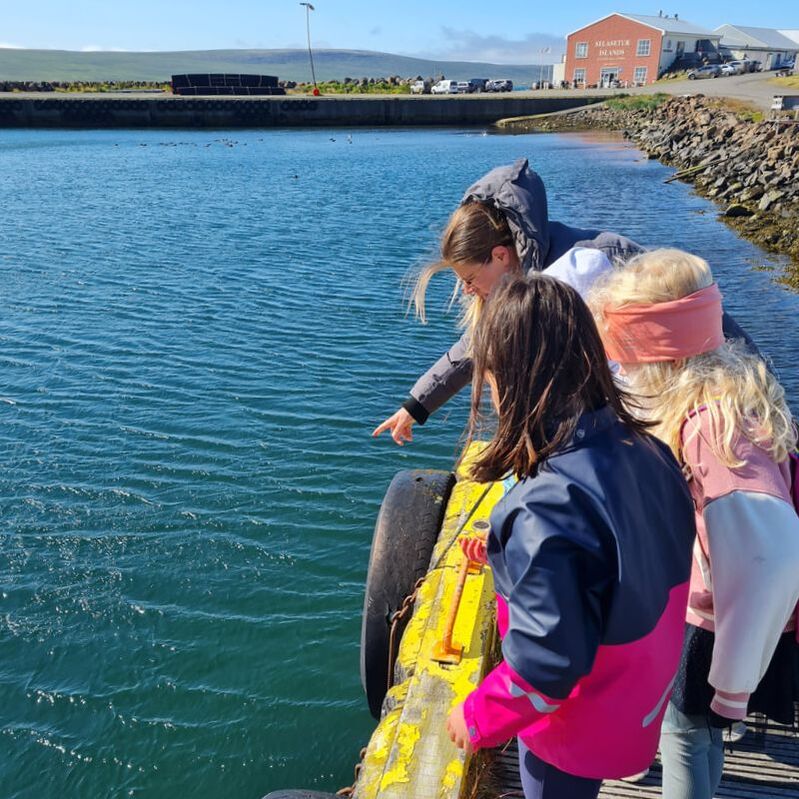|
We went out again on the 18th of July to see what kind of wildlife we could find in the Hvammstangi harbor. In Spring, the only crabs we found were spider crabs (Hyas araneus), but now in July the only species that seems to be around is the invasive Atlantic rock crab (Cancer irroratus). We found 5 yesterday, all of which were mature males. This pattern is consistent with previous years, and is probably due to these animals' life cycle: great spider crab mating occurs from February to April, while Atlantic rock crabs mate from August to September. It would be fascinating to study the transition in abundance of these two species in the shallow waters of Iceland, which occurs sometime between May and June. It is also interesting to note that all the individuals we found were males, which shows that females prefer deeper waters. All results from this year's harbor monitoring can be found on the free YAN app (see here for more information). References: Haefner, P.A. 1976. Distribution, reproduction and moulting of the rock crab, Cancer irroratus Say, 1917, in the mid-Atlantic Bight. J. Nat. Hist. 10: 377-397. https://doi.org/10.1080/00222937600770291 Harzsch, S., Miller, J., Benton, J., Dawirs, R. R., & Beltz, B. (1998). Neurogenesis in the thoracic neuromeres of two crustaceans with different types of metamorphic development. Journal of Experimental Biology, 201(17), 2465–2479. https://doi.org/10.1242/JEB.201.17.2465  Mature male Atlantic rock crabs. Males grow up to 15cm while females only grow up to 10cm, and males have a triangle-shaped abdomen while it is more rounded in females.
0 Comments
Meghan Orman is a PhD student at University of Pittsburgh, Fulbright fellow at University of Iceland, and Youth for Arctic Nature collaborator, with her main research interest being the exploration of how humans connect with nature. She spent the school year 2022-2023 in Iceland under a Fullbright grant to study nature connectedness and well-being in Icelandic preschoolers. In connection with her project, the Youth for Arctic Nature project funded her trip to Norway this year from the 2nd to the 9th of June, with the goal to strengthen our ties to academic and organizational communities in Tromsø.
Meghan met with Dr. Monika Abels, our board member at University of Tromsø, and her master’s student, Helenah Gustavsson, who will be doing research on young children’s nature connection this Fall very using similar methods to what she has done in Iceland. This could lead to a joint paper with Helenah about Arctic children’s relationships with the natural world, as well as a possible theory paper in collaboration with YAN project leader Dr. Jessica Aquino and Dr. Abels on critically examining cross-cultural understandings of nature connection. She also gave a talk on her research in Iceland to people in the UiT Psychology Department interested in the topic of young children’s nature connection. Finally, Monika, Helenah and Meghan met with Katrine Opheim, Arctic Frontiers advisor, at the Fram Centre. Arctic Frontiers a Tromsø-based organization with the goal to foster valuable Arctic research in Norway and beyond. They had a wonderful conversation about the work they are doing, the Fram Centre, and the potential for programming and research collaborations with YAN in the next year. Like YAN, Arctic Frontiers aim to foster curiosity and increase knowledge about Arctic research in youth, to foster international collaboration, and to generate scholarly knowledge. Thank you very much for your work Meghan, hoping to see you soon again in Iceland! |
Archives
March 2024
Categories
All
|











 RSS Feed
RSS Feed












